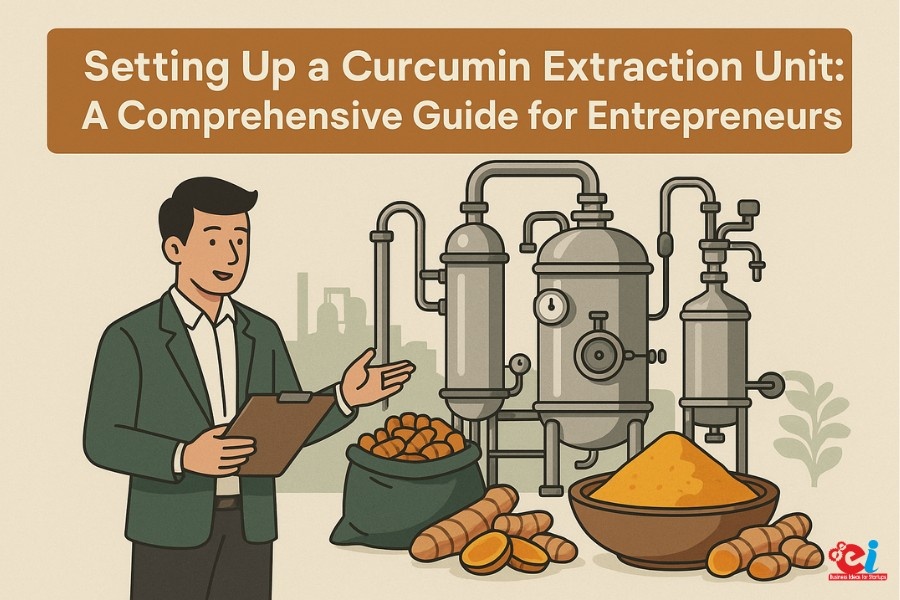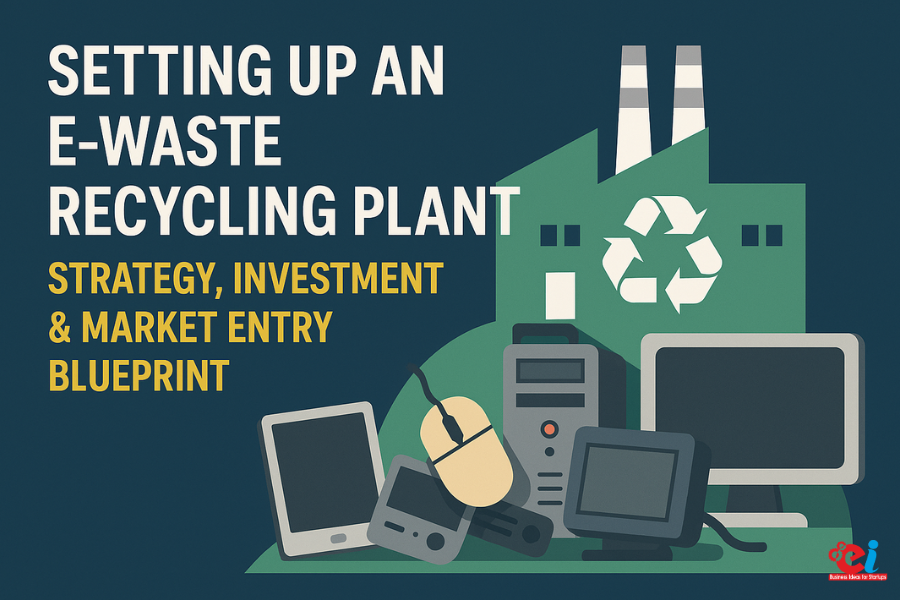The curcumin industry is growing at a remarkable rate because of India’s prominent role in turmeric cultivation. Turmeric is known for the bright yellow curcumin that is extracted from its roots. It has now taken the world stage due to its high demand for anti-inflammatory, antioxidant and even anti-cancer medicines. This compound has use in every industry ranging from health supplements and functional foods to even cosmetics and pharmaceuticals which amplifies its market. Setting a curcumin extraction unit is the most profitable venture for any entrepreneur seeking a natural and long term investment. This guide provides a comprehensive resource on the steps required to establish such units ranging from technical procedures to thorough legalities like compliance and market access.
The Science Behind Curcumin Extraction
Curcumin is a polyphenol extracted from the rhizomes of turmeric (Curcuma longa), a South Asian plant. The extraction process seeks to segregate curcuminoids which include curcumin, demethoxycurcumin and bisdemethoxycurcumin. These compounds are well known for their therapeutic and preventive benefits.
The scientific method of extraction commonly involves food grade solvents such as ethanol or acetone which leaches out curcuminoids from powdered turmeric. More advanced setups may employ supercritical CO₂ extraction, which does not leave any remnants of solvents so guarantees higher purity. In any case, the aim remains to produce a concentrated extract of curcumin with high purity for various commercial uses.
Sourcing High-Quality Raw Material
The extraction unit’s success relies on well planned purchacing strategy of turmeric. India has various regional differated toramrics, the best ones being Erode and Salem due to high curcumin content. Cooperative agreements with farmers guarantee sustainble supply. The dry turmeric should have a moisture content lower than 10%. Additionally, rhizomes should be devoid of mold, dirt, and any physical damages. Correctly washing, slicing, and drying of turmeric while ensuring its chemicals are preserved is crucial before powdering it for extraction.
Related: 20 Best Profitable Business Ideas in India for 2025: A Comprehensive Guide
Infrastructure and Facility Planning
The curcumin extraction facility should balance processing and regulatory compliance requirebents in their infrastructure. Each of the processing activities such as raw material fridge, pre cleaning and drying shed, pulverizing room, plus extraction and filtration unit, should have designated separators. Depending on extraction capacity, additional units such as boiler room, HVAC and fire safe solvent handling areas may be added.
To minimize contamination and improve workflow, a streamlined directional layout for unidirectional material flow is preffered. Production should have unobstructed access to water and electricity so one access utilities like wastewater treatment systems become crucial.
Required Equipment and Technology
The processing core of a curcumin extraction unit includes several units, namely, a turmeric washer, drier, and pulverizer. These units prepare the raw material. Curcuminoids are separated from the turmeric powder using either solvent extractors or reactors. The subsequent step involves concentrating the curcumin-rich solution using vacuum evaporation systems, which also reclaim and recycle solvent.
The crystallization tanks then allow the extract to undergo crystallization and the resultant solids are dried in either tray or vacuum dryer. Machinery that is optional, but highly recommended, includes: self-cleaning filters, custom designed dust collection systems, solvent recuperative condensers, and automated packing systems. Supercritical carbon dioxide extractors use solvent-free technology to make higher-grade products, but have a high investment cost.
Regulatory and Quality Compliance
There is considerable curcumin extraction compliance needed for food, health, and export market segments. An FSSAI license is mandatory for food and nutraceutical purposes. Ayurvedic formulation products require an AYUSH license. Use of solvents require Environmental clearance and a Permit from the State Pollution Control Board.
Other necessary safety certifications include Fire NOC, relevant to the factory, and general safety approvals. Quality control for curcumin should involve evaluating the percentage of curcumin, microbial load, heavy metals, residual solvents, and shelf-life validation either in-house or through third-party labs. ACH, ISO 22000, or HACCP along with GMP compliance enhances market reputation especially when selling to pharmaceutical or international clients.
Economic Overview and Cost Structure
The financial expenditure in setting up a curcumin extraction unit needs capital and operating expenses to be strategically intertwined. For an average-sized unit with a processing capacity of 100 to 200 kilograms of turmeric powder each day, the total investment is expected to be in the range of ₹55 lakhs to ₹85 lakhs. This encompasses the expenses of machinery, utilities, land development, safety infrastructure, laboratory setup, as well as a buffer working capital for the first few months of operations.
Owing to their sophisticated nature, Supercritical CO₂ extraction facilities alone can exceed costs of ₹2.5 crores. While these units are capital-intensive, they tend to yield high prices, but are best suited for export-centric production. Furthermore, these entrepreneurs need to consider recurring costs for procurement, labor, electricity, solvent replacement, maintenance, during profitability quantification.
Related: Why Curcumin Extraction is a Lucrative Business Opportunity?
Investigating Market Demand and Implementation of Sales Techniques
The health and wellness segment aligns well with the industry since curcumin is included in dietary supplements with anti-inflammatory properties as well as immunity boosters. It is also used in functional beverages, protein bars, capsules, tablets, and powderswhile being processed.
Besides serving as a natural coloring and preservative curcumin is utilized in the food and beverages industry. Due to its inflammatory and anti-oxidizing properties curcumin is infused in skin creams, face masks, and anti-aging products which makes the cosmetic sector use curcumin.
There are direct selling opportunities for B2B nutraceutical companies and pharmaceutical formulators specializing in created foods with dietary supplements as well as white label manufacturing for established brands. There is a rapidly growing market for exports in the USA, Canada, Germany, Japan, and South Korea.
Active participation in trade shows and advertisements through digital media like IndiaMART and Alibaba as well as government-sponsored programs aimed at improving access to the market are useful in accessing buyers and improving their visibility.
Risk Management and Operational Challenges
An curcumin extraction unit has its risks. The volatility in raw turmeric prices may stem from seasonality, demand cycles, weather conditions or a combination of all. This is mitigated through contract farming or bulk advance purchases.
The other challenge is ensuring quality control throughout the manufacturing process to guarantee the consistent quality of curcumin extract across different batches. Compliance begins with regulatory audits, fire safety, and solvent recovery compliance, all of which are part of the ongoing adherence that require supervision.
For solvent based units, safety is the highest priority and no breaches are permitted in proper storage, staff PPE, and maintenance of equipment. Environmental legislation regarding waste disposal and effluent treatment can be contended by installing small scale ETP units which is an easier approach to managing these matters.
Incentives from the Government and Export Possibilities
Curcumin has several proponents in India as it is considered an herbal extract of great value. The APEDA along with the Pharmexcil aid curcumin exporters with international marketing, export franchising, marketing mailouts, trade exhibition attendance, and buyer-seller interactions.
MSME undertakings in herbal processing also can get some form of assistance under the Pradhan Mantri MUDRA Yojana, CLCSS, and other technology advancement schemes. Under the Foreign Trade Policy, Exporters are eligible for subsidy reclamation on duty drawback, GST, transport expenditure, and other commendations.
By also registering as a manufacturer exporter, access to additional multinational name sponsorship and custom ingredient formulation contract opportunities become available.
Role of Niir Project Consultancy Services (NPCS)
Niir Project Consultancy Services (NPCS) has been a trusted name in industrial project planning, providing specialized guidance in setting up botanical extract units across India. For those aspiring to enter the curcumin extraction space, NPCS offers end-to-end support. This includes preparing customized detailed project reports, calculating accurate financial projections, helping with raw material linkages, and selecting the right machinery vendors. NPCS also offers regulatory guidance, plant layout plans, branding suggestions, and export-readiness strategies. With decades of experience in herbal, food, and chemical manufacturing sectors, NPCS ensures that your curcumin extraction unit is not only technically feasible but commercially successful.
Conclusion
The curcumin extraction industry represents the confluence of traditional knowledge and modern technology. In a world increasingly inclined toward natural remedies and sustainable practices, investing in a curcumin extraction unit is both timely and impactful. The business allows entrepreneurs to leverage India’s turmeric-rich agricultural base while entering high-margin markets like wellness, nutraceuticals, and herbal pharma.
Setting up a curcumin extraction unit requires planning, precision, and professional execution. With the right technical framework, regulatory preparation, and market strategy, even small and medium enterprises can build scalable operations that cater to domestic and global demand. As the herbal product ecosystem continues to grow, entrepreneurs willing to innovate and invest in quality will find curcumin to be more than just a compound—it’s a cornerstone of future-ready, green enterprise.

























